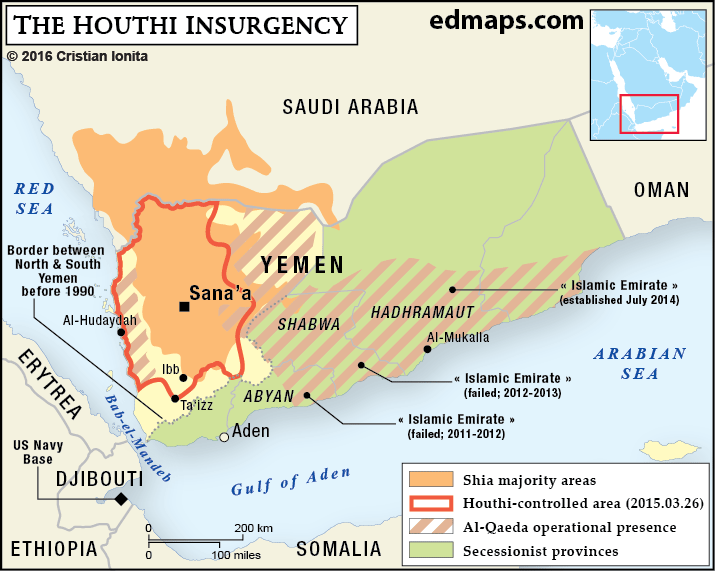Why in news?
- Renewed clashes broke out between Houthi rebel fighters and Saudi-backed pro-government forces in Yemen.
Click here to know more on Yemen Civil War; Click here for the ceasefire agreement.
What is the recent happening?
- The tussle in Yemen is essentially between Yemen’s Shia Houthi rebels loyal to the former President and the forces loyal to the current government.
- [The former is Ali Abdullah Saleh and the latter is Present Abdrabbuh Mansour Hadi.]
- The two factions claim to constitute the Yemeni government.
- Following the December 2018 ceasefire agreement, Houthi rebels were withdrawing from three of Yemen’s ports.
- But while the withdrawal was under way, Houthis, who are reportedly getting support from Iran, allegedly carried out a drone attack on a Saudi pipeline.
- In retaliation, Riyadh launched airstrikes on Sanaa, the capital city of Yemen controlled by the rebels.
- The attack killed at least six civilians, including children.
- Yemen now risks falling back to the pre-ceasefire days of conflict.
- Fighting is broken out in parts of the government-controlled south too.

How has Saudi's role been?
- Saudi Arabia started its Yemen military campaign in March 2015 with the goal of driving Houthis out of territories they captured.
- Four years of war have devastated the country of Yemen.
- According to the UN, at least 7,000 civilians have been killed.
- Thousands of others have died due to disease, poor health care and malnutrition.
- The blockade Saudi Arabia imposed on Yemen steadily worsened its hunger problem and health-care crisis, and is now on the brink of a famine.
- Even when the ceasefire was holding, the Saudis did not halt bombing Yemen.
- Saudi Arabia appears to be frustrated that it is not able to defeat the Houthis even after years of heavy bombing.
- The Houthis, on their part, continue to provoke the Saudis through cross-border rocket and drone attacks, both affecting the Yemenis severely.
Why is the recent attack so dangerous?
- The resumption of hostilities is more dangerous in the regional angle.
- Tensions are already on the rise in West Asia over the U.S.-Iran standoff. Click here to know more.
- The U.S. had earlier warned against possible attacks by either Iran or Iran-backed militias against American interests or its allies in the region.
- U.S. has also deployed an aircraft carrier and a bomber squad to the Gulf.
- Immediately after the pipeline was attacked, the Saudis blamed Iran for ordering it.
- Both Iran and the Houthis have refuted this allegation.
- Whatever the case be, the incident and subsequent Saudi airstrikes show how the Yemeni conflict is entangled with the rivalry between Iran and Saudi Arabia.
What is the way forward?
- Moving ahead, the Hodeida model should be replicated elsewhere in Yemen.
- Hodeidah is the city wherefrom Yemen’s government and Houthi rebels agreed on the first phase of a withdrawal.
- The ceasefire took effect in this Red Sea port city and both the rebels and government forces showed compliance till the rebels pulled out recently.
- It is only safe if the parties to the conflict continue talks under international mediation.
- For this to be achieved, the Houthis should decouple themselves from the regional politics.
- They should stay focussed on resolving differences with the government and rebuilding the war-torn country.
- Importantly, Saudi Arabia should get out of Yemen.
Source: The Hindu
